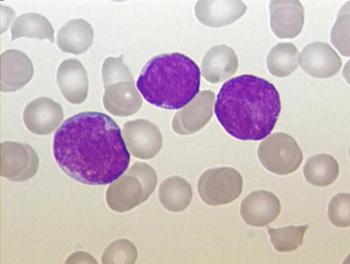
- ONCOLOGY Vol 16 No 3
- Volume 16
- Issue 3
Successful Treatment of Pure Red Cell Aplasia With Rituximab in Patients With Chronic Lymphocytic Leukemia
Pure red cell aplasia is a rare occurrence in patients with chronic lymphocytic leukemia (CLL). This report is based on two cases-CLL patients with documented pure red cell aplasia who responded remarkably to anti-CD20 or rituximab (Rituxan
Pure red cell aplasia is a rare occurrence in patients with chroniclymphocytic leukemia (CLL). This report is based on two casesCLL patientswith documented pure red cell aplasia who responded remarkably to anti-CD20 orrituximab (Rituxan).
Case 1 involves a 79-year-old man with B-cell CLL (trisomy 12) who presentedwith severe anemia with a hemoglobin below 8 g/dL in April 2000. His white bloodcell (WBC) count was 25,000/µL, with normal lactate dehydrogenase (LDH),negative Coombs, very low reticulocyte count (0.1%), and absent red blood cellprecursors in his bone marrow. He also had negative parvovirus B19 titers and ahigh erythropoietin level.
Despite therapy with cyclosporine (Neoral, Sandimmune) and prednisone, thepatient had no response and remained transfusion dependent for 6 months.Intravenous immunoglobulin was also tried at 1 g/kg for 2 days, to no avail.Rituximab was then started at 375 mg/m²/wk for 8 weeks, beginning October 2000.He became transfusion independent after the fourth treatment and hisreticulocyte count rose to 4% with normalization of hemoglobin (13 g/dL) and WBCcount (4,900/µL). Repeat bone marrow biopsy confirmed resolution of his pure redcell aplasia. As of January 2002, the patient remains in complete remission ofhis CLL and pure red cell aplasia.
Case 2 is a 47-year-old woman who had had B-cell CLL for the last 7 years.She was started on therapy with fludarabine (Fludara) in February 2000, based onrapid rise of her WBC count (160,000/µL) with normal hemoglobin at the time.After five cycles of therapy, her hemoglobin dropped to less than 8 g/dL and shebecame transfusion dependent. Her reticulocyte count was near 0%, with normalLDH and negative Coombs.
The patient was started on erythropoietin injections with still no response.After six cycles of fludarabine therapy, her WBC count was 12,000/µL with 10,000lymphocytes, and she was still blood transfusion dependent. Rituximab wasstarted in August 2000 at the same dose as the patient in case 1 above.Gradually, her hemoglobin normalized over 4 to 6 weeks, and she becametransfusion independent. Her reticulocyte count rose to 10%, WBC count was4,300/µL (40% lymphocytes), and hemoglobin was 13.5 g/dL. As of February 2002,she is still in remission.
CONCLUSION: To our knowledge, this is the first report of pure red cellaplasia in patients with CLL responding to rituximab therapy. We believe itdeserves further investigation.
Articles in this issue
almost 24 years ago
Single-Agent Rituximab in Early-Stage Chronic Lymphocytic Leukemiaalmost 24 years ago
Recruitment for Trial of Adjuvant Trastuzumab Under Wayalmost 24 years ago
Rituximab in the Treatment of Acquired Factor VIII Inhibitorsalmost 24 years ago
Support for New Medicare Pay Formulaalmost 24 years ago
Irinotecan-Containing Regimen Improves Survival in Small-Cell Lung CancerNewsletter
Stay up to date on recent advances in the multidisciplinary approach to cancer.

















































































